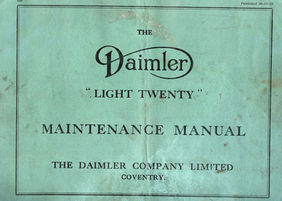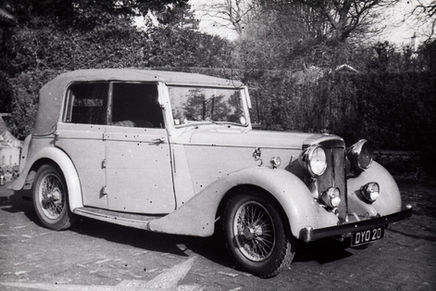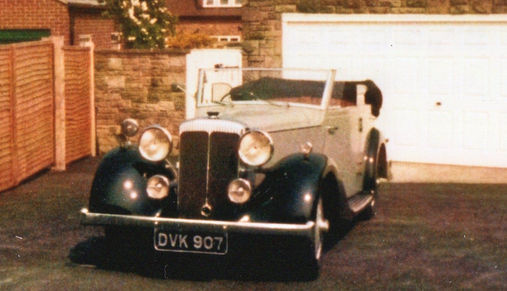Daimler Light Twenty/Twenty 1935 - 1939
Building on the success of the recently introduced Lanchester "Eighteen" model launched in the autumn of 1934, the Daimler "Light Twenty" was advertised by the company as early as the July of 1935 and was largely based on the Lanchester Eighteen with the exception of having a 2,565c.c.(19.3 R.A.C. HP) engine..
Number produced (maximum):
877
Chassis allocations:
41050 - 41249 = 200
42350 - 42551 = 202
42650 - 42974 = 325
47600 - 47749 = 150
Total = 877
Gear ratios:
1st ------- 4.08
2nd ------ 2.32
3rd ------- 1.56
Top ------ direct
Reverse - 5.4
Rear axle ratio - 5.14
RPM @ 60mph in top gear - 3,510
Fluid flywheel - 9 pints (recommend Straight 30 grade)
Gearbox - 4 1/2 pints (recommend Straight 30 grade)
Rear axle - 3 pints (recommend Straight 140 grade)
Petrol tank(inc. 2 gallons reserve) - 20 gallons
Tyres:
Size: 6.00 x 18
Pressure front - 31 lbs/sq.in.
pressure rear - 33lbs/sq.in
Chassis designation:
E20
USEFUL DATA:
Light Twenty (1935/6)
Engine (monobloc):
Number of cylinders:
6-in-line
Capacity (c.c.): 2,565
(72mm bore x 105mm stroke)
R.A.C. Rating: 19.3
Compression ratio: 6:1
Valve clearance:
Inlet - 52 thou; exhaust 54 thou.
Firing order: 1,5,3,6,2,4.
Sparking Plugs: NGK BP6ES (modern equivalent)
Cooling system capacity:
25 pints
Engine oil capacity: 15 pints
Transmission
Pre-selective Wilson gearbox mated to Daimler fluid flywheel
Capacities
Turning circle: 38ft
Wheelbase: 9ft 6ins
Track: 4ft 8ins
Length overall: 15ft 7ins
Ground clearance: 7ins
Weight of chassis: 22 1/2cwts
As for Light Twenty (1935/6) with the following exceptions:
Cooling system capacity: 18 pints
Engine oil capacity: 14 pints
Fluid flywheel - 8 1/2 pints
Gearbox - 5 pints
Rear axle - 2 1/2 pints
Tyre pressure: Front:30lbs/sq.in. Rear:34lbs/sq.in
Turning circle: 40 1/2 ft
Length overall: 15ft 3ins (Standard Saloon)
Weight of chassis: 21cwts
Weight of Standard Saloon:
31 1/2cwts
12th July 1935
The Autocar
"A New Daimler Light Twenty"
3rd August 1935
The Practical Motorist
" A New Daimler - The Light Twenty"
Dimensions
Road Test dates
USEFUL DATA:
Light Twenty/Twenty (1937 - 39)
History. Dave Philpot
Without looking to make excuses, the history of the design and launch of the Daimler "Light Twenty" is not an easy task to recount. This situation exists due to the bombing of the Daimler Co. offices during the hostilities of World War II, and the subsequent loss of a large proportion of the pre-war records. In fact, I have a letter in my possession outlining this fact to an owner wishing to purchase a spare parts book for his "Light Twenty", the Daimler Co. being unable to furnish his request.

In the period when the Daimler "Light Twenty" launched, it was usual for the next season's updated or new models to be launched by the Daimler Co. at the Motor Show held at Olympia in the October of the previous year. So, one would expect a new or updated model for, say, 1936, to launch at Olympia in October 1935. However, this does not seem to have been the case with the Daimler "Light Twenty". The car was not only road tested, but also advertised by the company as early as July 1935. The reason for this may have been that the Daimler Co. wanted to 'cash-in' on the success of the new Lanchester "Eighteen" model which had launched in the autumn of 1934, a car upon which the Daimler "Light Twenty" was largely based, with the exception of having a 2,565c.c.(19.3 R.A.C. HP) engine fitted, as opposed to the 2,390c.c. (17.97 R.A.C. HP) unit found in the Lanchester. It must be noted though, that soon after the launch of the "Light Twenty", the Lanchester model mentioned was 'upgraded' and fitted with the larger, more powerful unit found in the Daimler, whilst still retaining the model name of "Eighteen".

Although achieving moderate sales, as stated, the exact number of cars produced cannot be ascertained. Albeit a car found to have excellent driving qualities with good performance and such enhancements as servo-assisted brakes, sales can hardly have been helped by the Daimler Co. adopting an independent front suspension set-up on the new Daimler "Fifteen" (2,166c.c. DB17), and Lanchester "Fourteen Roadrider De-Luxe" (1,809c.c LA14/2 & 14/3), in 1937, making the handling characteristics of the earlier car seem somewhat archaic. This statement seems to be borne out by comparing model prices in 1936, to those of 1938: In 1936, the Daimler-bodied 6-light saloon would cost you from £675, whilst opting for the Salmons "Tickford All-Weather" coachwork would have taken the price to £885. By 1938, those two coachwork options would have cost £595 and £835 respectively.

The "Light Twenty" was somewhat of an 'oddity', as it was not built to replace an ageing, existing model (the LQ3 having a wheelbase that was greater by no less than ten inches), nor was it replaced by a new model! By late 1938, the Daimler "Fifteen" (which could trace its roots back to 1932), had become a 2 1/2 litre itself (2,522c.c. DB18/1), and so it has to be said that even if war had not broken out, production of the Daimler "Light Twenty", which by 1938 had become simply just the "Twenty" had run its course. Although no cars were thought to have been produced after 1939, with factory production turned over to the war effort, at least one "Twenty" is known to have been registered as late as 1941.

Coachbuilders:
The following coachbuilders are known to have built at least one body on the "E20" chassis. Again, this list is by no means exhaustive:
Charlesworth Bodies (1931) Ltd.
Coachcraft Ltd.
Daimler Co. Ltd.
Arthur Mulliner
Mulliners (Birmingham) Ltd.
Salmons & Sons
Martin Walter Ltd.
Windover
James Young & Co. Ltd.
The accompanying photographs and illustrations show various styles of coachwork offered by the above.
Maintenance Manuals & Spare Parts Catalogues
The accompanying cover scans illustrate the following:
Early "Light Twenty" Maintenance Manual, dated 30/11/35
Later "Light Twenty" Maintenance Manual, dated 1/1/37
"Twenty" Maintenance Manual, dated 11/38
T.C.102 Spare Parts Book (41,050 - 41,249 & 42,350 - 42,551)
T.C.109 Spare Parts Book (42,650 - 42,974 & 47,600 - 47,749)

Wiring Diagram
1937/38 Daimler Twenty wiring diagram.




























